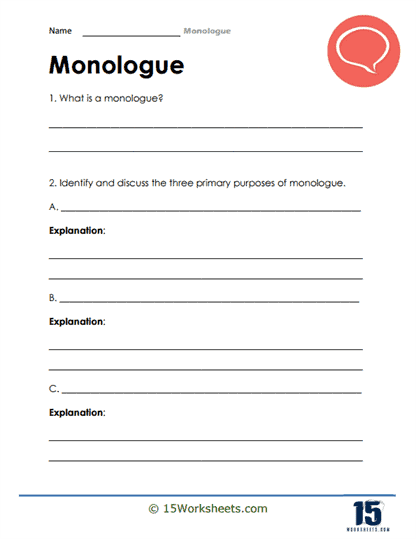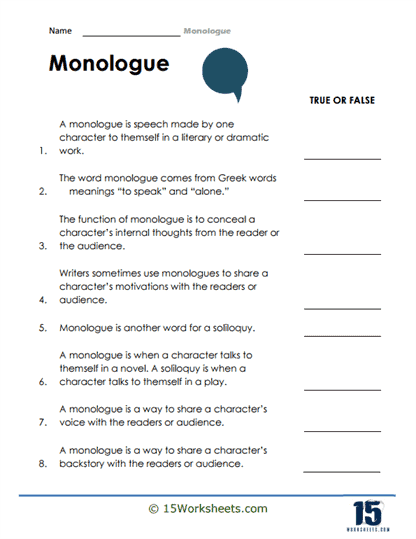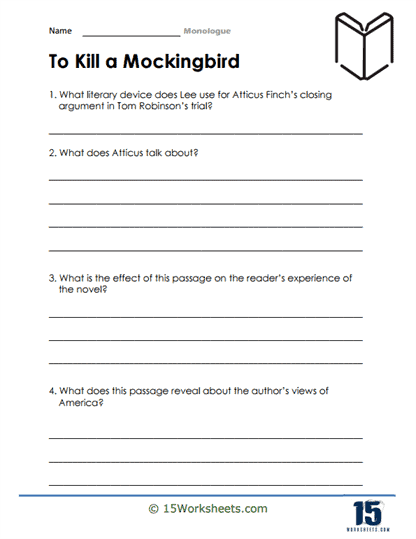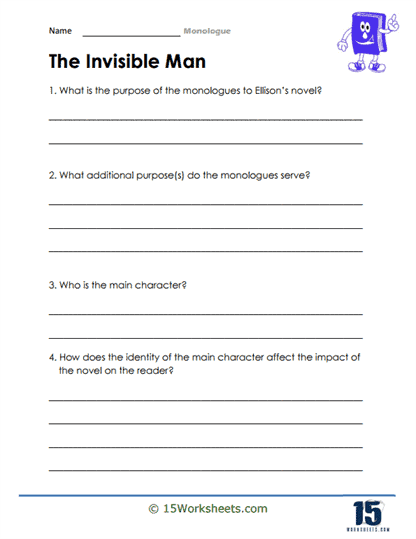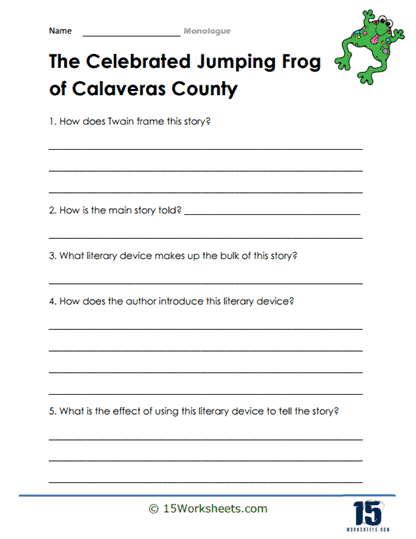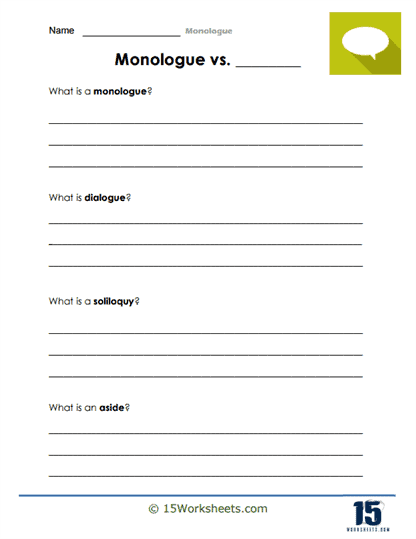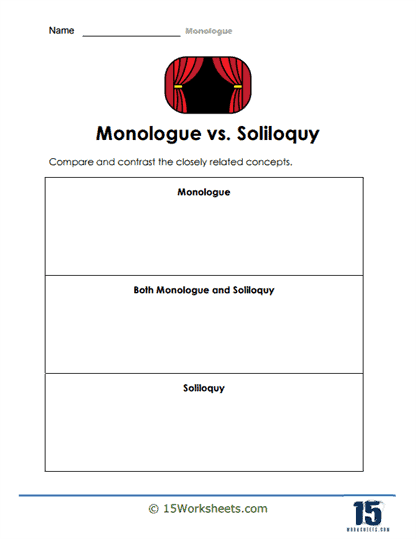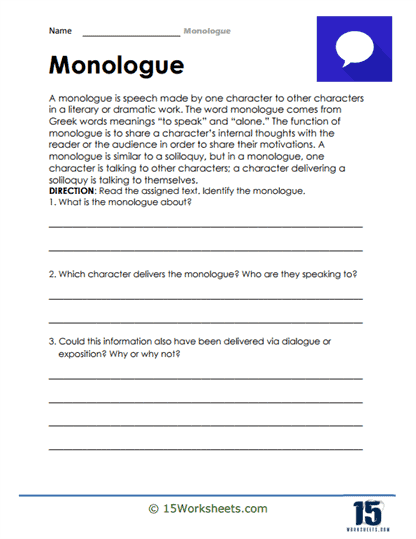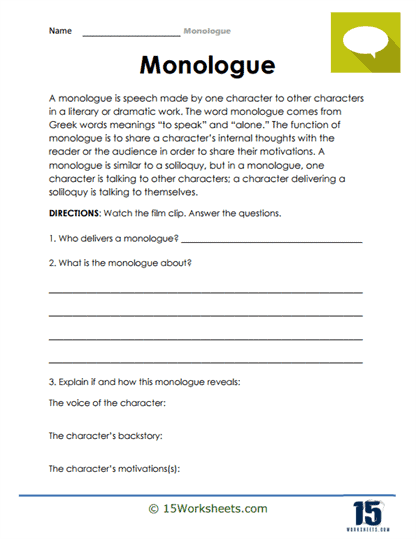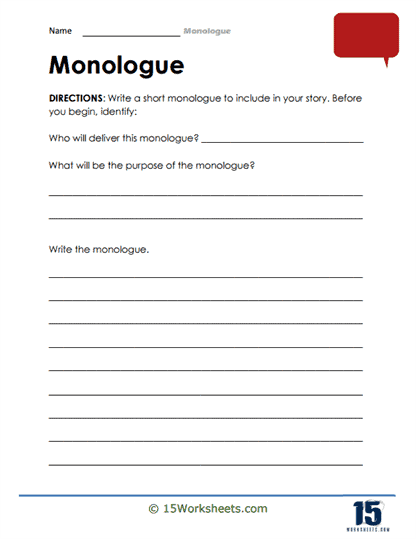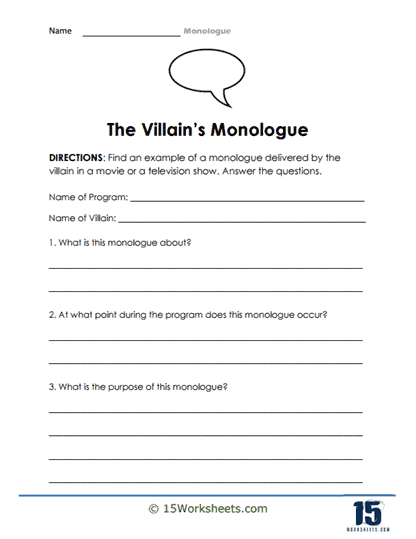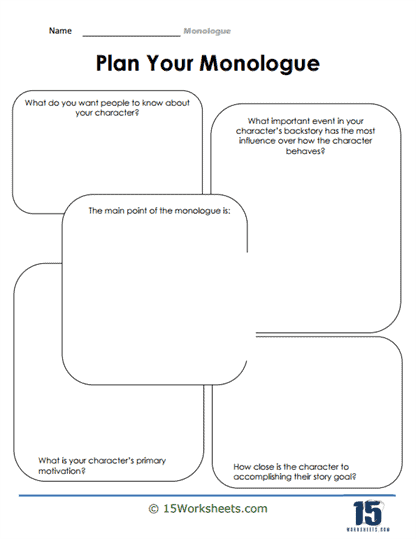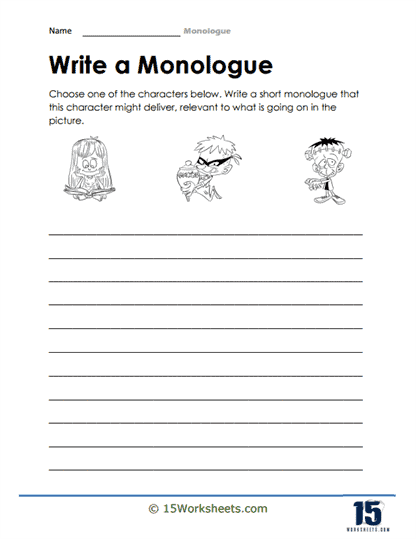Monologue Worksheets
All About These 15 Worksheets
Monologues, a powerful form of solo dramatic expression, are not only a fundamental aspect of theater but also an invaluable tool for developing communication skills, enhancing empathy, and fostering self-expression. Understanding monologues allows students to explore the art of performance, connect with complex characters and emotions, and refine their speaking and acting abilities.
This collection of 15 worksheets is designed to introduce students to the world of monologues, helping them grasp the importance of this form of dramatic expression, recognize its elements, and develop their own monologue-performance skills.
What Are Monologue Worksheets?
Monologue worksheets are educational tools designed to help middle school students understand and practice the literary technique of a monologue. A monologue is a long speech by a character in a play, film, or work of literature, typically expressing their thoughts aloud, sometimes directly addressing other characters or the audience. It serves as a means to understand a character’s inner thoughts, feelings, motivations, or plans.
These worksheets would be filled with exercises to help students grasp the concept of monologue and see how it works in different contexts. Here are some examples of the types of activities you might expect to find on a monologue worksheet:
Identification – One basic exercise could involve reading a passage from a play, film, or novel and identifying whether it’s a monologue. If it is, the student would need to state who the speaker is and possibly what the monologue reveals about the speaker’s character.
Analysis – Some exercises might ask students to analyze a given monologue in terms of its purpose, tone, mood, and themes. They might need to think about why the author chose to use a monologue at this particular point in the story and what the monologue contributes to the overall plot or character development.
Writing Monologues – For a more creative exercise, students could be asked to write their own monologue. This could involve creating a new character and scenario, or writing a monologue for a familiar character from a book they’ve read or a movie they’ve seen.
Comparisons – Some worksheets might contain exercises that require students to compare and contrast different monologues. This could be based on various factors such as length, emotional intensity, information revealed, and more.
These types of exercises not only help middle school students to gain a deep understanding of what a monologue is, but they also aid in enhancing their analytical and creative writing skills. Working on monologue worksheets helps to improve students’ comprehension of dramatic texts and other literature, and encourages them to think critically about character development and narrative structure.
What is the Literary Device of Monologue?
A monologue is a lengthy speech by a single character in a work of literature, drama, or film, often expressing their thoughts aloud or directly addressing other characters or the audience. It’s a powerful literary tool that allows readers or viewers to delve deeper into a character’s psyche, understand their motivations, or observe their thought processes.
Defining Feature of a Monologue
The primary characteristic of a monologue is that it involves a solitary speaker addressing a silent listener or audience. It’s an uninterrupted piece of speech that can vary in length, from a few lines to several pages. It provides a unique insight into a character’s feelings, thoughts, and emotions. The nature of a monologue can be dramatic, comedic, tragic, or narrative depending on the purpose it serves in the context.
Examples of Monologue in Literature
Hamlet’s “To be, or not to be” Monologue from Shakespeare’s “Hamlet”
One of the most famous monologues in all of literature is Hamlet’s “To be, or not to be” soliloquy. Here, Hamlet contemplates life and death, weighing the pain and unpredictability of life against the fear of the unknown in death. This soliloquy provides deep insight into Hamlet’s state of mind and his philosophical nature. He grapples with heavy existential questions, showcasing the depth of his despair and inner turmoil.
“The Love Song of J. Alfred Prufrock” by T.S. Eliot
This poem is essentially a monologue by the character of J. Alfred Prufrock, a man contemplating the banality and emptiness of his life. Through this monologue, readers get a vivid picture of Prufrock’s anxiety, indecisiveness, and poignant self-awareness. It reveals his internal struggle, his feelings of isolation, and his fear of rejection and failure.
Mr. Darcy’s Proposal in “Pride and Prejudice” by Jane Austen
In Austen’s novel, Mr. Darcy’s first proposal to Elizabeth Bennet serves as a monologue where he confesses his love against his better judgment. This speech not only serves to move the plot forward but also gives readers a deeper insight into Mr. Darcy’s character. He reveals his internal conflict between his feelings for Elizabeth and his concerns about her family’s lack of social standing. His monologue is a turning point that catalyzes Elizabeth’s (and the reader’s) reassessment of his character.
A monologue serves multiple purposes in literature and drama. It lets the audience into the private thoughts, feelings, and motivations of a character, humanizing them and making them more relatable. It can move the plot forward, create suspense, add dramatic effect, and enhance character development.
In the given examples, we can see the wide range of ways a monologue can be used. Whether it’s Hamlet grappling with existential questions, Prufrock expressing his anxieties, or Mr. Darcy declaring his love, each monologue is tailored to the character and the situation, revealing something crucial about both.

